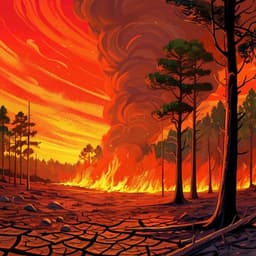
Environmental Studies and Forestry
Metal toxin threat in wildland fires determined by geology and fire severity
A. M. Lopez, J. L. Pacheco, et al.
This groundbreaking study by Alandra Marie Lopez, Juan Lezama Pacheco, and Scott Fendorf uncovers a hidden danger of catastrophic wildfires: the release of toxic chromium. As climate change fuels these fires, the carcinogenic hexavalent chromium (Cr(VI)) levels soar, posing a significant health risk through smoke and ash. Discover how this silent threat persists long after the flames are out.
~3 min • Beginner • English
Introduction
Wildfire smoke and dust present an increasing global health risk, with fine particulate matter (PM2.5) from wildfires demonstrating greater toxicity than PM2.5 from many other sources. While organic pollutants in smoke have been widely studied, the chemical composition of wildfire-derived particulates and the role of toxic metals remain poorly characterized. Hexavalent chromium [Cr(VI)] is a known respiratory carcinogen that can form from naturally occurring trivalent chromium [Cr(III)] in soils when heated during fires. Many populated regions overlay metal-rich mafic/ultramafic geologies where soil Cr concentrations are elevated, raising concern that wildland fires may generate hazardous levels of Cr(VI) in ash and dust. This study investigates how geologic substrate (felsic to ultramafic), ecosystem type, and fire severity control Cr(VI) formation and its persistence in surficial soils and wind-dispersible particulates during and after recent California wildfires (2019 Kincade; 2020 Hennessey/LNU Complex), with implications generalizable to global metal-rich landscapes.
Literature Review
Prior work shows wildfire PM2.5 is more harmful than urban or prescribed burn sources, likely due to differing physical and chemical properties. Heavy metals in wildfire PM have been detected and linked to oxidative stress, cytotoxicity, and increased cancer risks. Chromium is typically present in soils as relatively benign Cr(III), but heating above ~200 °C accelerates oxidation to carcinogenic Cr(VI); experiments indicate up to ~35–40% of total Cr in certain minerals/soils may convert under specific conditions. Urban/wildland-urban interface ash has contained Cr(VI) up to ~3200 µg kg−1 post-fire, and controlled burns have shown substantial post-burn increases in Cr(VI) in surface soils. Geologically, ultramafic/mafic terrains with high natural Cr (and Ni, Fe, Mn) are widespread in many fire-prone regions worldwide. The temperature dependence of Cr(VI) formation and the role of alkali/alkaline earth metals (e.g., Ca, K, Mg) in catalyzing Cr(III) oxidation during heating have been documented. However, field-based evidence from wildland settings and the persistence and size-fraction distribution of reactive Cr(VI) in post-fire ash/soil remain limited.
Methodology
Study area and design: Field sampling was conducted in California’s North Coast Range (Sonoma, Napa, and Lake Counties) following the 2019 Kincade Fire and the 2020 Hennessey Fire (LNU Lightning Complex). Four ecological preserves spanning diverse vegetation (grassland, chaparral, forest) and contrasting geologies (felsic rhyolite/rhyodacite; mélange; ultramafic serpentinite; sandstone) were sampled: Pepperwood Preserve, Sonoma Land Trust’s White Rock Preserve, Audubon Canyon Ranch’s Modini Preserve, and UC’s McLaughlin Natural Reserve. Burn severity classifications (unburned, low, moderate-high) were based on landscape fire history, post-fire field observations (vegetation, ash/soil color), and laboratory indicators (soil mineralogy, NH4+). Sampling timeline: Preserves affected by Kincade Fire were sampled immediately post-containment (Nov 2019) and ~11 months later (Sept 2020). McLaughlin was sampled Sept 19, 2020 (during Hennessey Fire period) with resampling of surface ash/soil on July 29, 2021. Sampling: 38 intact soil cores (5×30 cm) were collected: 22 burned and 16 unburned (10 serpentine, 16 mélange, 7 rhyolitic, 5 sandstone; ecosystems: 19 grasslands, 10 chaparral, 9 mixed forests). Cores were sectioned: 0–6 cm in 1-cm increments; 6–16 cm in 2-cm increments. Depths >10 cm served as control depths except in extremely severe burns. In severely burned serpentine chaparral, bulk surface soil-ash layers (disaggregated ash/soil) were collected. Sample preparation: Samples were homogenized and sieved (<2 mm). For surface ash/soil, additional sieving isolated silt/clay-sized, wind-dispersible fraction (<53 µm) without grinding to preserve aggregates. Particle-size distributions (0.4–53 µm) for select samples were measured by laser diffraction. Gravimetric water content was measured (1–11% within 0–16 cm). Bulk chemistry and mineralogy: Total major/trace elements were measured by energy-dispersive XRF. XRD was used qualitatively to assess thermal mineralogical changes (e.g., forsterite indicating >575–600 °C serpentine dehydroxylation). Micro-scale spectroscopy: Thin sections of <53 µm particulates (high- and low-severity sites) were analyzed by µ-XRF mapping at multiple energies (Cr(VI) pre-edge 5993 eV; Cr(III) 6003 eV; total Cr 6010 eV) and µ-XANES at SSRL to identify Cr speciation and elemental associations (e.g., Ca, K). Image processing employed thresholds and intensity ratios to estimate relative Cr(VI) abundance in Cr-bearing particles. Aqueous extractions: Reactive (water/adsorption-available) Cr(VI) was extracted using 10 mM phosphate buffer (pH 7.2) at 1:4 solid:solution, 24 h shake, then filtered (0.22 µm). Cr(VI) was quantified by diphenylcarbazide colorimetry (LOD 3 µg L−1 ≈ 12 µg kg−1). Total dissolved Cr in extracts was measured by ICP-MS to confirm predominance of Cr(VI). Exchangeable NH4+ was measured via flow injection analysis to support severity classification. Statistics: Normality assessed by Shapiro–Wilk; equal variances by F-test. Depending on assumptions, parametric (paired/unpaired t-tests) or nonparametric (Mann–Whitney U, Wilcoxon signed-rank) tests compared reactive Cr(VI) between burned/unburned near-surface soils, between surface and control depths within cores, and across severities. Global context: A GIS analysis combined a generalized global mafic/ultramafic geology map with GlobFire fire perimeters (2001–2020) to visualize frequencies of large fires (>2023 ha) in metal-rich regions alongside population distribution to infer exposure potential.
Key Findings
- Geology controls Cr(VI) formation: Fire-affected soils with higher total Cr (e.g., serpentinite) had the greatest reactive Cr(VI) after burning. In serpentinite-derived soils, near-surface (0–2 cm) reactive Cr(VI) increased significantly in burned vs. unburned soils (p=0.041), while deeper control depths (10–16 cm) showed no significant differences (p=0.25). Rhyolitic and mélange sites (lower severity conditions) showed minimal or non-significant near-surface changes.
- Fire severity effect: In serpentine chaparral, severely burned sites averaged >200 µg kg−1 reactive Cr(VI) at 0–2 cm, 6.5-fold higher than unburned chaparral soils (35 µg kg−1, p=0.0001) and 3.6-fold higher than burned control depths (>10 cm; 63 µg kg−1, p=0.0109). Low severity sites had modest, non-significant increases (73 vs. 35 µg kg−1; p=0.173). Extremely high soil temperatures (>800 °C) in some forest sites corresponded to lower reactive Cr(VI), reflecting complex temperature dependence.
- Surface ash/soil layers concentrate Cr(VI): In severely burned serpentine chaparral, bulk surface soil-ash layers (<2 mm) contained up to 3335 µg kg−1 reactive Cr(VI); site averages at moderate–high severity were ~1073 µg kg−1, nearly 5× the top 1-cm soil average (219 µg kg−1). These exceeded the US EPA residential soil screening level (300 µg kg−1). Low-severity ash layers averaged 36–82 µg kg−1.
- Persistence: Under drought (25.1 cm rainfall vs. ~74.3 cm average), reactive Cr(VI) in surface ash/soil persisted for ~10 months post-fire, ranging 64–1060 µg kg−1 (median 257 µg kg−1), remaining elevated relative to unburned serpentine near-surface soils (5–64 µg kg−1), though not statistically significant in that comparison (p=0.164).
- Wind-dispersible fraction enriched and hazardous: Surface ash/soil contained 12–22% particles <53 µm; respirable particles <10 µm comprised ~27–30% (8–12% <2.5 µm). Within <53 µm particulates, reactive Cr(VI) ranged 327–13,100 µg kg−1, generally similar to or higher than bulk ash/soil and exceeding EPA screening levels. µ-XRF/µ-XANES detected Cr(VI) on mineral surfaces and in Ca/K-enriched low-Cr particles at high-severity sites, but not at low severity. Fine fractions from low-severity sites sometimes showed 9–14× higher reactive Cr(VI) than corresponding bulk.
- Global exposure potential: Mafic/ultramafic terrains coincide with many populated, fire-prone regions on all vegetated continents; satellite-derived fire frequencies (2001–2020) indicate recurring large fires in these metal-rich landscapes, implying widespread potential for Cr(VI)-bearing smoke/dust exposure.
- Proportion of total Cr: Under natural wildfire conditions in burned serpentine soils, up to ~0.015% of total Cr was present as reactive Cr(VI), highlighting that even small fractions can reach toxicologically relevant concentrations in fine particulates.
Discussion
The study demonstrates that wildland fires can thermally oxidize geogenic Cr(III) to toxic Cr(VI) in soils and ash, particularly in metal-rich geologies and under moderate to high severity burns, thereby directly addressing the question of how geology and fire severity influence Cr(VI) formation and persistence. Elevated reactive Cr(VI) in near-surface soils and especially in wind-dispersible fine particulates creates acute and chronic inhalation risks during and after fires. Persistence over many months under dry conditions extends exposure windows for nearby communities, land workers, and first responders. The enrichment of Cr(VI) in fine fractions aligns with known mechanisms of metal transport via dust resuspension post-fire. Temperature dependence (limited formation at low severity; potential decrease at extremely high temperatures) underscores the importance of fire behavior. The global overlay of metal-rich terrains with recurring fires implies that the hazard is not localized to California; similar processes likely occur in tropical lateritic regions and other mafic/ultramafic settings, though the extent may vary with mineralogy and fire regimes. Recognizing chemical-specific risks beyond aggregate PM metrics helps explain why wildfire smoke can be particularly harmful and informs targeted risk mitigation and monitoring strategies.
Conclusion
Wildland fires on metal-rich geologies generate toxic, reactive Cr(VI) in soils and ash, with the greatest production in ultramafic/mafic-derived soils under moderate to high fire severity. Reactive Cr(VI) is concentrated in wind-dispersible fine particulates, often exceeding health-based screening levels, and can persist in surface layers for many months in dry post-fire conditions, posing ongoing inhalation risks. These findings clarify a geogenic, fire-catalyzed pathway for metal toxin exposure that likely contributes to the elevated health impacts of wildfire smoke. Future work should develop predictive tools integrating geology, fuel/vegetation, and fire behavior to forecast Cr(VI) generation and guide protective measures for responders and communities. Field investigations in other geologic contexts (e.g., lateritic Ferralsols) and comprehensive monitoring of inhalable particle size fractions and speciation across diverse fire regimes are needed to refine exposure assessments and mitigation strategies.
Limitations
- Spatial and temporal scope: Sampling was conducted at four preserves in Northern California following two fires, with limited resampling; results may vary in other regions and climates.
- Severity classification and heterogeneity: Burn severity was inferred from field observations and supporting lab metrics; fine-scale heterogeneity in fire intensity/duration may not be fully captured.
- Analytical constraints: The µ-XRF pixel resolution (~1–10 µm) approaches or exceeds sizes of the most respirable particles (<2.5 µm), potentially missing or under-quantifying Cr(VI) in ultrafine fractions; thresholding may exclude low-intensity, Cr-bearing fine particles; particles highly enriched in Cr(III) may lead to underestimation of Cr(VI) by pre-edge mapping.
- Detection limits/statistics: Some measurements near detection limits and non-normal distributions reduced statistical power, leading to non-significant differences in certain comparisons (e.g., persistence vs. unburned).
- Generalizability of mineralogical controls: The extent of Cr(VI) formation depends on mineral hosts and fire temperatures; extremely high temperatures (>800 °C) can reduce reactive Cr(VI) formation. Field data from lateritic/tropical soils remain sparse, limiting generalization to those settings.
- Global fire frequency mapping: Satellite-derived fire size/frequency may not capture all regimes (e.g., WUI small fires) and does not directly translate to exposure risk, which also depends on proximity, intensity, and meteorology.
Related Publications
Explore these studies to deepen your understanding of the subject.







